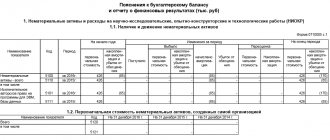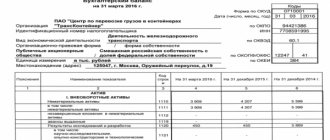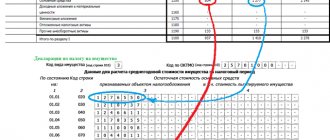Who is obliged to attach explanations to the financial statements?
An explanatory note is required as part of the annual reporting of all organizations that maintain full accounting records.
An exception is organizations entitled to simplified accounting:
- small businesses;
- non-profit organizations;
- participants of the Skolkovo project.
Such entities have the right to report on a reduced set of accounting forms and are not required to provide explanations, or provide them only in relation to the most important information, without which it is impossible to assess the financial condition of the company.
Who should include explanatory notes in the annual report
Such a document will be required by all enterprises and organizations submitting financial statements. The note displays information that cannot be included in other reporting forms. In this case, it is necessary to take into account the fact that the information under consideration is of interest not only to the tax authorities, but also to the founders and creditors of the enterprise. For example, if the tax on profit received in the new reporting period turned out to be noticeably lower than in the previous one. To avoid legal consequences and possible claims from the Federal Tax Service, the reasons for this event can be stated in an explanatory note to the prepared reports.
What data is included in the notes to the financial statements in 2021
The explanatory note must reflect information about the accounting policies, because its provisions establish the accounting rules for the enterprise. Additional data not included in the main reports helps assess the financial condition of the entity and the reasons for the current situation as of a specific date.
PBU 4/99 determines the content of the notes to the balance sheet and financial statements:
- data at the beginning and end of the year, as well as the movement of intangible assets, fixed assets, accounts receivable and payable, financial investments and capital;
- composition of income and expenses;
- composition of reserves;
- extraordinary facts of economic life and their consequences;
- conditional facts of economic life, events after the reporting date, etc.
The procedure for preparing explanatory notes
It should be noted here that there is no unified template for drawing up this document, so each company develops its own template for such a note.
However, there are a number of points that must be displayed when filling out. Read also: Personal income tax when selling an apartment
Document structuring
The sections included in the explanatory note are indicated here. They are approved by the head of the organization and can be arranged in any order. For example, like this:
- General information;
- Accounting policy;
- Comparative analysis of indicators;
- Balance sheet assessment and analysis;
- Explanations on the articles of the report;
- Information about joint activities with other enterprises;
- Data on individual business segments and regional branches;
- Information on transactions with affiliates;
- Data on pending litigation and disputes with the Federal Tax Service;
- Data on state support and sponsorship.
Initial data
This may include:
- Information about the subject’s commercial activities;
- Analytical data on items of income and expenses;
- Assessment of the current financial situation;
- Important notes and transcripts of significant information.
Additionally, financial and economic stability, the degree of possible risks, and financial independence can be noted.
Sample design
Explanatory note to the balance sheet sample
Analytics
Here is an assessment of the objectivity of this information with explanations. For example:
- How detailed is the information provided?
- Are all factors affecting the financial statements noted;
- Are changes in the material and financial situation indicated;
- How accurate is the assessment of the business activity of the enterprise;
- Have the key points of commercial activity been identified?
- Relevance of analytics for the financial outcome.
Who is interested in explanations of financial statements?
Explanation of financial statement indicators is necessary for a fairly wide range of interested parties, including:
| Interested people | Cause |
| State control authorities (including the Federal Tax Service) | Explanation of the dynamics of indicators, transcript of articles |
| Owners | Explanation of financial result |
| Creditors | Assessing the readiness of the debtor organization to repay the debt |
| Investors | Assessing the stability of the organization and its investment attractiveness |
What form is used to prepare an explanatory note for 2019?
Clause 4 of Order No. 66n of the Ministry of Finance of Russia dated 07/02/2010 provides for the provision of explanations in tabular or text form. These methods can be combined. The organization independently decides what data requires clarification, but must take into account the recommended forms from Appendix No. 3 to Order No. 66n.
The document is usually drawn up according to the following plan:
- Information about the organization: location; Kind of activity; information about managers, founders and affiliates, etc.
- Data on accounting policies: methods of evaluating products, inventories; methods of calculating depreciation, information about changes in accounting policies during the year, if any.
- Financial indicators for the reporting year: revenue and costs by type of activity; It is possible to decipher large income and expense transactions.
- Actually, explanations for individual balance sheet items.
The specifics of the company’s activities in each specific case determine which indicators should be excluded and which ones should be added.
Explanatory note to financial statements - sample in 2020
Explanations for the balance sheet can be formatted as follows:
| Explanations to the accounting (financial) statements LLC "Bread Factory No. 3" for 2021 1. General information Limited Liability Company (LLC) "Bread Factory No. 3" was registered by the Federal Tax Service No. 18 for Moscow on September 02, 2012, OGRN 1117711111111, INN 7711123456, KPP 771101001; legal address: Moscow, st. Lenina, house 155. 1.1. Authorized capital: 1,800,000 (one million eight hundred thousand) rubles (fully paid). 1.2. Founders and affiliates of the organization:
1.3. The main activity of the organization according to OKVED: 10.71.1 - Production of bread and non-durable bakery products. 1.4. The number of employees as of December 31, 2021 is 77 people. 1.5. There are no branches, representative offices or other separate divisions. 2. Basic accounting policies The accounting policy of LLC Bread Factory No. 3 was approved by order of the General Director O.N. Saushkin. dated December 28, 2018 No. 162. 2.1. A non-linear depreciation method is used. There is no revaluation of fixed assets. 2.2. The financial result from the sale of products and goods is determined by shipment. 2.3. Inventory and finished products are assessed at actual cost. 2.4. The write-off of inventories into production is carried out at an average cost. 3. Financial indicators The general meeting of founders on February 17, 2020 approved the financial statements for 2021. The accounting (financial) statements of Bread Factory No. 3 LLC for 2021 were generated based on the accounting and reporting rules in force in the Russian Federation. 3.1. Net profit at the end of 2021 amounted to RUB 5,841,600. Payment of dividends to the founders in accordance with their shares in the authorized capital was made on 02/20/2020. 3.2. Revenue for 2021, rubles:
3.3. Costs of production and sales of products in 2021, rubles:
4. Explanation of balance sheet items as of December 31, 2019 4.1. Fixed assets: Name | As of 12/31/2018 | Change | As of 12/31/2019 | ||||
| Initial cost | Depreciation | Received | Dropped out | Accrued depreciation | Initial cost | Depreciation | |
| Fixed assets of all, including: | 1 300 300 | 1 001100 | 2 192 100 | 45 200 | 341 100 | 3 447 200 | 1 342 200 |
| Building | 900 100 | 800 800 | 1 200 600 | — | 200 300 | 2 100 700 | 1 001 100 |
| Equipment | 400 200 | 200 300 | 90900 | 45 200 | 90700 | 445 900 | 291 000 |
| Vehicles | — | — | 900 600 | — | 50 100 | 900 600 | 50 100 |
4.2. MPZ
| Name | As of 12/31/2018 | Change | As of 12/31/2019 | |
| Cost price | Received | Dropped out | Cost price | |
| MPZ total, including: | 846200 | 79600 800 | 79 806 500 | 640500 |
| Raw materials | 820 400 | 36 500 100 | 36 680 000 | 640 500 |
| Finished products | 25 800 | 43 100 700 | 43 126 500 | — |
4.3. Accounts receivable
| View | As of 12/31/2018 | Change | As of 12/31/2019 | |||||
| Accounted for under the terms of the contract | Reserve | Admission | Disposal | Accounted for under the terms of the contract | Reserve | |||
| Redeemed | Written off | Reserve restored | ||||||
| Accounts receivable total, incl. | 18 100 500 | — | 76 701 700 | 68 601 100 | 27 700 | — | 26 173 400 | — |
| according to payments to suppliers | 2900 300 | — | 1 500 400 | 2 300 600 | 1 300 | — | 2 098 800 | — |
| according to settlements with buyers | 15200 200 | — | 75 201300 | 66 300 500 | 26 400 | — | 24 074 600 | — |
4.4. Accounts payable
| View | As of 12/31/2018 | Change | As of 12/31/2019 | |||||
| Accounted for under the terms of the contract | Reserve | Admission | Disposal | Accounted for under the terms of the contract | Reserve | |||
| Redeemed | Written off | Reserve restored | ||||||
| Accounts payable total, incl. | 33 547 400 | — | 47 900 300 | 49 800 600 | 45 900 | — | 31 601 200 | — |
| Short-term total, including: | 23 600 700 | — | 47 900 300 | 46 200 400 | — | — | 25 300 600 | — |
| according to payments to suppliers | 22 100 500 | — | 38 300 100 | 36 500 100 | — | — | 23 900 500 | — |
| according to budget calculations | 1 500 200 | — | 9 600 200 | 9 700 300 | — | — | 1 400 100 | — |
| Long-term total, including: | 9 946 700 | — | — | 3 600 200 | 45 900 | — | 6 300 600 | — |
| according to payments to suppliers | 45 900 | — | — | — | 45 900 | — | — | — |
| on credits, loans | 9 900 800 | — | — | 3 600 200 | — | — | 6 300 600 | — |
4.5. Salary
There are no payables and receivables for wages as of December 31, 2019.
The average number of employees as of December 31, 2019 is 77 people.
General Director of LLC "Bread Factory No. 3" Saushkin O.N. Saushkin
22.02.2020
What is stated in the document
Let's briefly go over the main points.
Business entity data
- Full name;
- Organizational and legal form of management;
- Legal address and actual location;
- Information about licenses: date of issue and validity period;
- Information on the number of employees working during the reporting period;
- Founders and authorized capital of the enterprise;
- Details of the legal entity;
- The total amount of taxes paid at the end of the year.
Accounting policy
- The procedure for accounting for assets and liabilities;
- The need to make changes;
- Forecasted consequences;
- A note indicating that the financial statements have been adjusted.
Assets and Liabilities
This section includes several subparagraphs.
Basic tools:
- Initial assessment and recalculation taking into account depreciation at the beginning and end of the reporting period;
- Useful life period;
- Methodology for determining depreciation and the method of displaying this information in accounting;
- Information on the turnover of basic funds: crediting to the balance sheet, writing off, etc.;
- Property undergoing state registration, but already in operation;
- Own types of fixed assets at the beginning and end of the reporting period;
- Leased/borrowed fixed assets in the reporting period;
- Objects with non-repayable value;
- Assets that provide for the fulfillment of obligations in non-cash equivalent;
- Items accounted for as retained earnings.
Production and material stock
- Assessment methodology for each type;
- Possible consequences of changing the assessment methodology;
- Amount and turnover of inventories.
Borrowed funds
- Availability of loans, credits, bills and bonds, indicating the type, amount of debt and repayment terms;
- The rate for the use of borrowed funds;
- Financial costs for borrowed funds included in current expenses.
Investments
- Evaluation of each type of investment;
- The value of securities and other investments encumbered with collateral;
- Information on the transfer of securities to other persons;
- Valuation of debt obligations;
- The amount of reserve allocated for asset depreciation.
Investments and liabilities in foreign currency
- The difference in exchange rates attributed to the financial result and accounted for in another way;
- The official rate dictated by the Central Bank at the time of filing financial statements.
Explanatory note to the balance sheet
Analytical assessment of balance and dynamics
Short term prospects:
- Liquidity forecast - critical, absolute, current;
- Providing with own assets;
- Probability of credit recovery;
- Profitability;
- Financial activity - activity, stability, dependence.
Read also: Accounting for settlements with contractors
Current creditworthiness:
- The volume of money supply in the cash register and in current accounts;
- Losses;
- Existing accounts payable and receivable;
- Loans and credits not repaid on time;
- Debt to the budget: presence or absence;
- Fines - paid and outstanding;
- Analytical assessment of the position of the company's securities on the stock market.
Long term prospects:
- Dependence on external investment;
- Sources of financing.
Profit and loss of the enterprise
- Sales volume of goods or services provided;
- Production costs;
- Available reserves;
- Other items of income and expenses;
- Force majeure affecting commercial activities and their consequences.
Explanations on significant accounting items
This section is completed in cases where there is significant information not shown in the financial statements.
Business activity
- Sales market, including export deliveries of products;
- The company's reputation in the commercial sphere;
- Mandatory implementation of planned indicators and ensuring their stable growth;
- Effective use of own resources.
Change in opening balance
- Reasons for the change: reorganization, new accounting requirements, etc.;
- The magnitude of the current changes.
Affiliates
- A complete list of such persons;
- Criteria classifying an individual or enterprise as an affiliate;
- The nature of partnerships;
- Joint operations, indicating prices for each type;
- Share of assets owned by affiliates.
Conditional factors
- Characteristics of obligations and deadlines;
- Existing uncertainties;
- Dedicated reserves;
- Possible consequences.
Partnerships
- Agreements of simple partnerships;
- Partnership goals;
- The company's contribution to joint activities;
- Volume and value of generalized assets;
- Profit received or loss incurred;
- Data on combined assets and transactions performed.
Report by company segments
- Full list of segments: subsidiaries, dependent companies, unions, associations;
- Revenue from sales to third parties and between segments;
- Financial results;
- Total assets and liabilities;
- The volume of capital investments in fixed assets and intangible assets, including depreciation;
- Share of net profit and financial costs based on the results of joint activities.
Events that occurred after the date of filing the report
- The reasons that led to these events.
- Likely consequences.
State support
- Amount of allocated funds;
- Special purpose;
- Forms of government support;
- Report on fulfilled and unfulfilled obligations.
Environmental component
- Company activities that have a negative impact on the environment;
- Activities carried out to protect the environment and the amount of funds allocated for this.
Information disclosure
- Number of shares issued: fully paid, partially paid, unpaid;
- The par value of securities owned by the issuer and its subsidiaries.
When re-issuing, the following shall be indicated:
- Cause;
- Date of issue;
- Conditions of accommodation;
- Number of securities;
- The volume of investments received.
Information included in the report based on PBU 18/02
- Conditional income tax expense/income;
- Differences that triggered the adjustment of conditional income/expenses;
- Amount of tax liabilities;
- Reasons for changing the tax rate;
- Volume of tax assets and liabilities.
Termination of business activities
- Description of the business activity that will be discontinued;
- Termination date;
- The total value of the company's assets and liabilities;
- Cash flow statement;
- Amounts of expenses and income before taxes;
- Profit and loss associated with disposal of assets.
Read also: How to create a vacation schedule
Other indicators
- Information reflecting the effectiveness of the company’s activities;
- Competitiveness of goods and services in the market;
- Solvency, credit policy and history;
- Information about property held as collateral or in trust.





